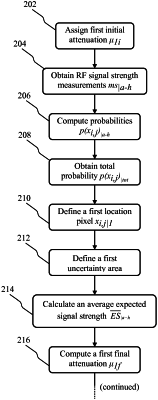| CPC G01S 5/02521 (2020.05) [G01S 5/0278 (2013.01); G01S 19/42 (2013.01); H04W 64/00 (2013.01)] | 18 Claims |

|
1. A method of identifying a position of a user equipment within a wireless communication network including at least one radio communication station transmitting radio signals over a geographic area, the method comprising:
a) identifying a sector portion used as an initial search space within the geographic area based on a timing advance value used in communications with the at least one radio communication station, the timing advance value corresponding to a length of time a signal takes to reach the at least one radio communication station from the user equipment;
b) providing expected radio signal strengths produced by the at least one radio communication station on each of a plurality of elementary area elements in which the initial search space of the geographic area is subdivided;
c) defining an initial attenuation experienced by the radio signals provided by the at least one radio communication station to the user equipment whose position is to be identified based on a table that lists a plurality of predetermined attenuation values, in decibels, for unmodeled obstacles;
d) obtaining measured radio signal strength measurements of the radio signals provided to the user equipment whose position is to be identified;
e) determining an estimated elementary area element corresponding to the position of the user equipment whose position is to be identified based on the expected radio signal strengths, the initial attenuation, and the radio signal strength measurements; and
f) computing a final attenuation on the basis of the estimated elementary area element,
wherein the c)-f) are iterated at least twice, with each further iteration of c which comprises defining the respective initial attenuation for the each further iteration on the basis of at least one final attenuation previously computed in f) of at least one previous iteration.
|